#504 The Martian Spring
Credit: November 04, 1996

“As spring comes to the northern latitudes of Mars, increased solar heating brings warmth and a change in the weather. The winds produced by the large temperature differences between the receding polar ice and the warming regions to the south may cause dust storms - like the one visible in the above Hubble Space Telescope images made in September this year. On the left, north is up and the Martian polar cap is seen at the top with dark regions along its southern border. The dust storm, about 600 miles wide, is visible against the white polar ice as a salmon colored notch. The image on the right presents the data showing the dust storm on a map grid centered on the north pole. Mars is famous for planet wide dust storms but studies of more localized weather patterns are difficult without high resolution images like those provided by the Hubble. As NASA prepares future missions to Mars, detailed studies of Martian weather patterns become increasingly important."
Copyright: Public domain
#505 The Coma Cluster of Galaxies
Credit: November 05, 1996
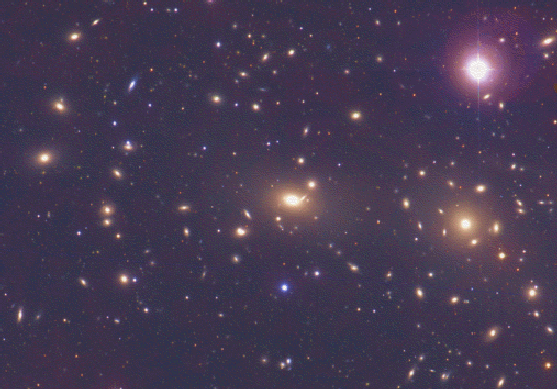
“Almost every object in the above photograph is a galaxy. The Coma Cluster of Galaxies pictured is one of the densest clusters known - it contains thousands of galaxies. Each of these galaxies house billions of stars - just like our own Milky Way Galaxy. Although nearby when compared to most other clusters, light from the Coma Cluster still takes hundreds of millions of years to reach us. In fact, the Coma Cluster is so big it takes light millions of years just to go from one side to the other! Most galaxies in Coma and other clusters are ellipticals, while most galaxies outside of clusters are spirals. The nature of Coma's X-ray emission is still being investigated. "
Copyright: Public domain
#506 Elliptical Galaxy NGC 4881 in Coma
Credit: November 06, 1996
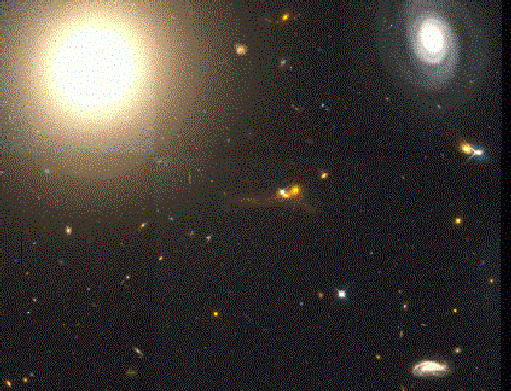
“cal galaxies are unlike spiral galaxies and hence unlike our own Milky Way Galaxy. The giant elliptical galaxy named NGC 4881 on the upper left lies at the edge of the giant Coma Cluster of Galaxies. Elliptical galaxies are ellipsoidal in shape, contain no spiral arms, contain little interstellar gas or dust, and are found mostly in rich clusters of galaxies. Elliptical galaxies appear typically yellow-red, as opposed to spirals which have spiral arms that appear quite blue. Much speculation continues on how each type of galaxy can form, on whether ellipticals can evolve from colliding spirals, or spirals can be created from colliding ellipticals, or both. Besides the spiral galaxy on the right, all other images in this picture are of galaxies that lie well behind the Coma Cluster. "
Copyright: Public domain
#507 Fields of Minerals on Ganymede
Credit: November 07, 1996
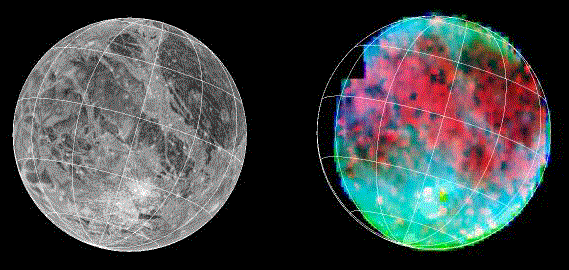
“What treasures lie on the surface of Ganymede? Last week, NASA released a map of Jupiter's largest moon made by the Galileo Orbiter highlighting ice and minerals deposits. The leftmost photograph by Voyager shows surface features in visible light, but the rightmost photograph, taken in infrared light by Galileo, shows the locations of minerals in red and ice grains in blue. The NIMS team is working to identify these minerals with preliminary hopes of finding emission indicative of montmorillonite and alunite"
Copyright: Public domain
#508 A Solar Corona Ejection
Credit: November 08, 1996
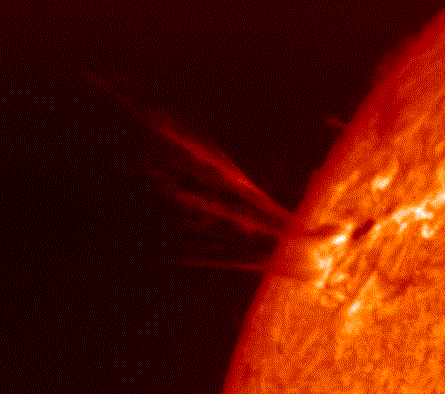
“The Sun would not be a nice place to spend the summer. One reason, besides the extreme heat, is that explosions are common there. In the above picture, magnetic fields buckle releasing previously constrained hot material from the upper atmosphere of the Sun. As a result, hot gas streams out into the Solar System, impacting planets, moons, spacecraft, and making space a dangerous place for astronauts. Known as coronal mass ejections (CMEs), billions of tons of scathing plasma can be accelerated to millions of miles per hour. CMEs are more common but less intense than solar flares. "
Copyright: Public domain
#509 Surveyor Hops November 09, 1996
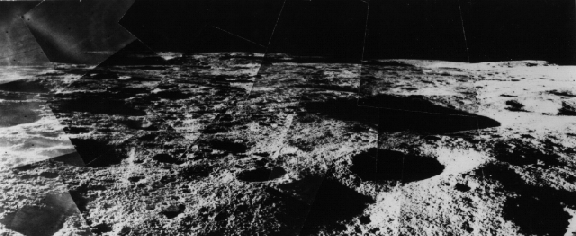
“This panorama of the cratered lunar surface was constructed from images returned by the US Surveyor 6 lander. Surveyor 6 was not the first spacecraft to accomplish a soft landing on the Moon ... but it was the first to land and then lift off again! After touching down near the center of the Moon's nearside in November of 1967, NASA controllers commanded the spacecraft to hop. Briefly firing its rocket engine and lifting itself some 4 meters above the surface, the Surveyor moved about 2.5 meters to one side before setting down again. The hopping success of Surveyor 6 essentially marked the completion of the Surveyor series main mission - to determine if the lunar terrain was safe for the planned Apollo landings."
Copyright: Public domain
#510 Columbia Launches November 10, 1996

“Rocket engines blazing, the Space Shuttle Columbia arcs into Florida's morning sky after lifting off from pad 39-A at Kennedy Space Center. Seen here in January of 1996, this space shuttle has been operational for more than 15 years -- racking up 20 flights and over 77 million miles in orbit while spending 177 days in space. The first member of NASA's shuttle fleet, Columbia shares it name with another famous spacecraft launched from pad 39-A, the Apollo 11 command module. Having begun its career with STS-1 in April of 1981, Columbia, also kown as orbiter vehicle 102 (OV-102), is now being prepared for the STS-80 mission scheduled to launch this month."
Copyright: Public domain
#511 NGC 4755: A Jewel Box of Stars
Credit: November 11, 1996
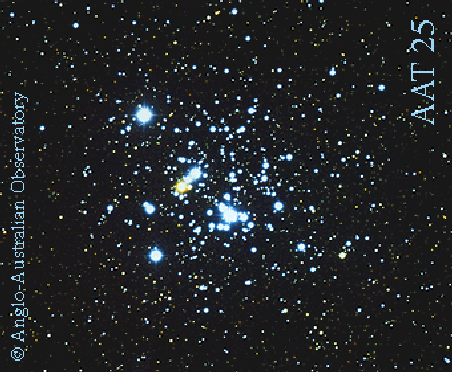
“The great variety of star colors in this open cluster underlie it's name: The Jewel Box. The bright central star Kappa Crucis is red, in contrast to the many blue stars that surround it. The cluster contains just over 100 stars, and might be no older than 10 million years. Open clusters are younger, contain few stars, and contain a much higher fraction of blue stars than do globular clusters. This Jewel Box lies about 7500 light-years away, so the light that we see today was emitted from the clusters before even the Great Pyramids in Egypt were built. "
Copyright: Anglo-Australian Telescope Board
#512 Comet Hale-Bopp Passes M14
Credit and Copyright: November 12, 1996
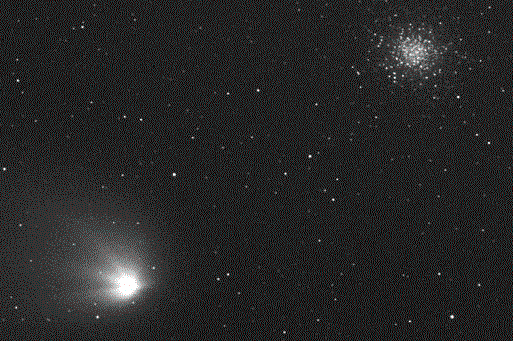
“Comet Hale-Bopp continues its slow trek across the night sky, and can now be seen superposed near the bright globular cluster M14. Will Comet Hale-Bopp become as bright in early 1997 as Comet Hyakutake did in early 1996? It is still too early to tell. Currently Hale-Bopp is curiously holding at about 5th magnitude - just barely bright enough to see without binoculars from a dark location. Because of the size of coma, some speculate that the nucleus of Hale-Bopp is unusually large. The actual nucleus is obscured, however, and recent speculation includes that the nucleus is comparable in size to Comet Halley - about 10-15 km across. "
Copyright: Public domain
#513 Seven Jets from Comet Hale-Bopp
Credit: November 13, 1996
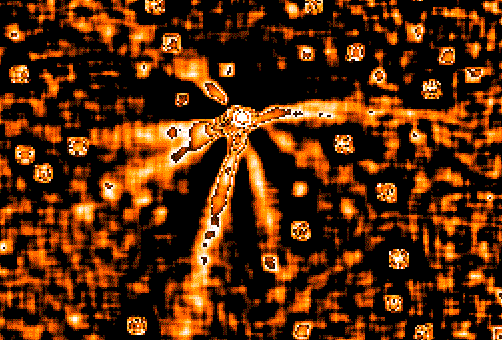
“Comet Hale-Bopp is turning out to be quite unusual. One reason is the great amount of jet activity at such a large distance from the Sun. In the above false-color image, no less than seven jets can be seen emanating from Hale-Bopp's coma. As a comet nears the Sun, it's surface warms causing jets of previously trapped gas and dust to stream away from the nucleus. Astronomers continue to study Comet Hale-Bopp's unusual jet activity and wonder how much about the early Solar System Hale-Bopp will teach them, and how bright Hale-Bopp will ultimately become. "
Copyright: Public domain
Upvote! Resteem! Comment! As you like it! Thank you for attention!